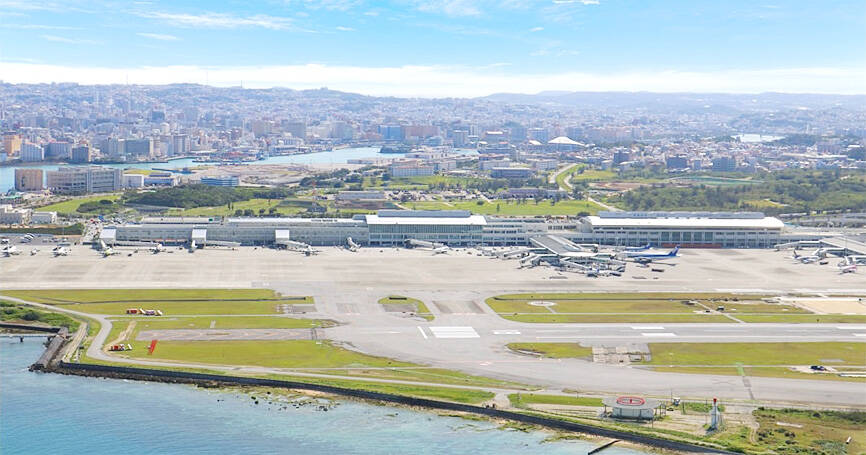Japan is mulling upgrades to five airports and 11 ports for use during military emergencies, including a potential “Taiwan contingency,” the Mainichi Shimbun reported on Wednesday, citing an unnamed government official.
The list of designated hubs includes Kitakyushu Airport off Kyushu, Naha Airport in Okinawa, the Port of Kushiro in Hokkaido and the Port of Ishigaki in Okinawa, which is about 230km east of Taiwan, the newspaper reported.
Nearly half of the facilities slated for improvement are in Kyushu and Okinawa, reflecting Tokyo’s apparent concern for the security of its outlying southwestern islands and possibly a Chinese invasion of Taiwan, it said.

Photo: Screen grab from Naha Airport’s X account
The plan is expected to be approved soon at a Cabinet meeting to allow work to begin in April next year, with an anticipated budget of ¥35 billion (US$231.26 million) for the first year, it said.
The 2022 edition of Japan’s National Security Strategy stipulated that the nation should lengthen runways at airports and add quays at ports to improve their serviceability to military aircraft and warships.
As of August last year, 33 facilities in 10 prefectures were being considered, a list that was later narrowed to 16 facilities in seven prefectures where residents voted to approve the military’s presence, Nikkei Asia reported on Thursday.
The 16 facilities are to be used by the Japan Self-Defense Forces and the Coast Guard as staging areas for personnel and supplies, refugee evacuation and humanitarian relief during natural disasters, Nikkei Asia reported.
The improved capacity of the facilities are also expected to provide a boost to tourism and commercial logistics, it said.
Tokyo had considered more facilities in Okinawa Prefecture, but canceled the plans amid opposition from local residents, it reported.
In other news, the US government has awarded a sole-source contract to upgrade Taiwan’s surveillance radar system that went online more than a decade ago, news Web site Breaking Defense said in a report on Tuesday.
A post on the US government’s procurement information Web site did not reveal the contract’s value, saying only that it was fixed and the contract would be implemented over 18 months, Breaking Defense said.
The upgrades aim to “increase the air surveillance capability for the system. This effort will further enhance the air surveillance mission software capabilities,” a US Air Force spokesperson was quoted as saying.
The radar infrastructure was designed to spot incoming ballistic and cruise missiles, and hostile aircraft, it said.

‘CHARM OFFENSIVE’: Beijing has been sending senior Chinese officials to Okinawa as part of efforts to influence public opinion against the US, the ‘Telegraph’ reported Beijing is believed to be sowing divisions in Japan’s Okinawa Prefecture to better facilitate an invasion of Taiwan, British newspaper the Telegraph reported on Saturday. Less than 750km from Taiwan, Okinawa hosts nearly 30,000 US troops who would likely “play a pivotal role should Beijing order the invasion of Taiwan,” it wrote. To prevent US intervention in an invasion, China is carrying out a “silent invasion” of Okinawa by stoking the flames of discontent among locals toward the US presence in the prefecture, it said. Beijing is also allegedly funding separatists in the region, including Chosuke Yara, the head of the Ryukyu Independence

UNITED: The premier said Trump’s tariff comments provided a great opportunity for the private and public sectors to come together to maintain the nation’s chip advantage The government is considering ways to assist the nation’s semiconductor industry or hosting collaborative projects with the private sector after US President Donald Trump threatened to impose a 100 percent tariff on chips exported to the US, Premier Cho Jung-tai (卓榮泰) said yesterday. Trump on Monday told Republican members of the US Congress about plans to impose sweeping tariffs on semiconductors, steel, aluminum, copper and pharmaceuticals “in the very near future.” “It’s time for the United States to return to the system that made us richer and more powerful than ever before,” Trump said at the Republican Issues Conference in Miami, Florida. “They

GOLDEN OPPORTUNITY: Taiwan must capitalize on the shock waves DeepSeek has sent through US markets to show it is a tech partner of Washington, a researcher said China’s reported breakthrough in artificial intelligence (AI) would prompt the US to seek a stronger alliance with Taiwan and Japan to secure its technological superiority, a Taiwanese researcher said yesterday. The launch of low-cost AI model DeepSeek (深度求索) on Monday sent US tech stocks tumbling, with chipmaker Nvidia Corp losing 16 percent of its value and the NASDAQ falling 612.46 points, or 3.07 percent, to close at 19,341.84 points. On the same day, the Philadelphia Stock Exchange Semiconductor Sector index dropped 488.7 points, or 9.15 percent, to close at 4,853.24 points. The launch of the Chinese chatbot proves that a competitor can

‘VERY SHALLOW’: The center of Saturday’s quake in Tainan’s Dongshan District hit at a depth of 7.7km, while yesterday’s in Nansai was at a depth of 8.1km, the CWA said Two magnitude 5.7 earthquakes that struck on Saturday night and yesterday morning were aftershocks triggered by a magnitude 6.4 quake on Tuesday last week, a seismologist said, adding that the epicenters of the aftershocks are moving westward. Saturday and yesterday’s earthquakes occurred as people were preparing for the Lunar New Year holiday this week. As of 10am yesterday, the Central Weather Administration (CWA) recorded 110 aftershocks from last week’s main earthquake, including six magnitude 5 to 6 quakes and 32 magnitude 4 to 5 tremors. Seventy-one of the earthquakes were smaller than magnitude 4. Thirty-one of the aftershocks were felt nationwide, while 79